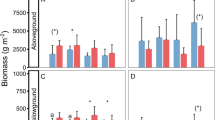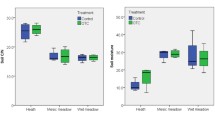Abstract
Aims
The magnitude of the change in tree growth caused by climate warming can be highly dependent on biological context, including factors such as the presence of associated decomposers and their behaviors. We test the hypothesis that 1) the presence of earthworms modifies the response of soil inorganic N and tree growth to warming via the change of cast production; and furthermore 2) the type of soil as food for earthworm differentiate the earthworm response and its effects on the plant-soil system.
Methods
We conducted a microcosm experiment rearing a geophageous earthworm species (Aporrectodea rosea) and birch (Betula ermanii) seedlings with two types of soil (sedimentary soil and serpentine soil) under two temperature regimes (ambient and ambient +3.3 °C).
Results
While the warming increased the cast production by the earthworms in the serpentine soil, it did not influence cast production in the sedimentary soil. The net nitrogen mineralization rate and the net inorganic N production showed similar dynamics to cast production under the warmer conditions, although the net nitrification rate did not. A significant increase in tree height from warming was observed only in the serpentine soil with earthworms, and the tree height was positively correlated with inorganic N production.
Conclusions
The context-dependent change of soil N dynamics to warming could be caused by differential feeding activity of earthworm, and it results in the modification of the growth characteristics of birch seedlings.


Similar content being viewed by others
References
Curry JP, Schmidt O (2007) The feeding ecology of earthworms—a review. Pedobiologia 50:463–477
Daugbjerg P (1988) Temperature and moisture preferences of three earthworm species (Oligochaeta, Lumbricidae). Pedobiologia 32:57–64
Dávalos A, Nuzzo V, Stark J, Blossey B (2013) Unexpected earthworm effects on forest understory plants. BMC Ecol 13:48
David JF, Gillon D (2009) Combined effects of elevated temperatures and reduced leaf litter quality on the lifehistory parameters of a saprophagous macroarthropod. Glob Chang Biol 15:156–165
Edwards CA (2004) Earthworm ecology, 2nd edn. CRC Press, Boca Raton, Florida
Eisenhauer N, Fisichelli NA, Frelich LE, Reich PB (2012) Interactive effects of global warming and ‘global worming’ on the initial establishment of native and exotic herbaceous plant species. Oikos 121:1121–1133
Haimi J, Boucelham M (1991) Influence of a litter feeding earthworm, Lumbricus rubellus, on soil processes in a simulated coniferous forest floor. Pedobiologia 35:247–256
Hillebrand H, Borer ET, Bracken ME, Cardinale BJ, Cebrian J, Cleland EE, Elser JJ, Gruner DS, Harpole WS, Ngai JT, Sandin S, Seabloom EW, Shurin JB, Smith JE, Smith MD (2009) Herbivore metabolism and stoichiometry each constrain herbivory at different organizational scales across ecosystems. Ecol Lett 12:516–527
Hishi T, Urakawa R, Tashiro N, Maeda Y, Shibata H (2014) Seasonality of factors controlling N mineralization rates among slope positions and aspects in cool-temperate deciduous natural forests and larch plantations. Biol Fertil Soils 50:343–356
Hubers H, Borges S, Alfaro M (2004) The oligochaetofauna of the Nipe soils in the Maricao State Forest, Puerto Rico. Pedobiologia 47:475–478
Irino KO, Kang Y, Kenzo T, Hattori D, Ishizuka S, Ninomiya I, Iwasaki K, Kendawang J, Sakurai K (2005) Performance of pot-grown seedlings of the Dipterocarp Dryobalanops lanceolata with controlled-release fertilizer after transplantation to the shifting cultivation and in Sarawak, Malaysia. Soil Sci Plant Nutr 51:369–377
LeBauer DS, Treseder KK (2008) Nitrogen limitation of net primary productivity in terrestrial ecosystems is globally distributed. Ecology 89:371–379
Kawaguchi T, Kyoshima T, Kaneko N (2011) Mineral nitrogen dynamics in the casts of epigeic earthworms Metaphire hilgendorfi: Megascolecidae. Soil Sci Plant Nutr 57:387–395
Makoto K, Arai M, Kaneko N (2014) Change the menu? Species-dependent feeding responses of millipedes to climate warming and the consequences for plant–soil nitrogen dynamics. Soil Biol Biochem 72:19–25
Marhan S, Auber J, Poll C (2015) Additive effects of earthworms, nitrogen-rich litter and elevated soil temperature on N2O emission and nitrate leaching from an arable soil. Appl Soil Ecol 86:55–61
Kitayama K, Aiba S, Majalap-Lee N, Ohsawa M (1998) Soil nitrogen meneralization rates of rain forests in a matrix of elevations and geological substrates on Mount Kinabalu, Borneo. Ecol Res 13:301–312
Krab EJ, Oorsprong H, Berg MP, Cornelissen JHC (2010) Turning northern peatlands upside down: disentangling microclimate and substrate quality effects on vertical distribution of Collembola. Funct Ecol 24:1362–1369
Mathieu J, Davies TJ (2014) Glaciation as an historical filter of below-ground biodiversity. J Biogeogr 41:1204–1214
Nakamura Y (1972a) Ecological studies on the family Lumbricidae from HokkaidoI. Ecological distribution Jpn Soc Appl Entomol Zool 16:18–23
Nakamura Y (1972b) Morphological observations of cocoon, larva and adult of Lumbricidae. Bull Natl Grassl Res Inst 1:6–16
Ott D, Björn CR, Brose U (2012) Climate change effects on macrofaunal litter decomposition: the interplany of temperature, body masses and stoichiometry. Philos Trans Roy Soc B 367:3025–3032
Pansu J, De Danieli S, Puissant J, Gonzalez JM, Gielly L, Cordonnier T, Zinger L, Brun JJ, Choler P, Taberlet P, Cécillon L (2015) Landscape-scale distribution patterns of earthworm inferred from soil DNA. Soil Biol Biochem 83:100–105
Perreault JM, Whalen JK (2006) Earthworm burrowing in laboratory microcosms as influenced by soil temperature and moisture. Pedobiologia 50:397–403
R Development Core Team (2014) R: A language and environment for statistical computing. R Foundation for Statistical Computing, Vienna, Austria, ISBN 3-900051-07-0. URL. http://www.R-project.org/.
Rouifed S, Handa IT, David JF, Hättenschwiler S (2010) The importance of biotic factors in predicting global change effects on decomposition of temperate forest leaf litter. Oecologia 163:247–256
Rowlands DJ, Frame DJ, Ackerley D, Aina T, Booth BBB, Christensen C, Collins M, Faull N, Forest CE, Grandey BS, Gryspeerdt E, Highwood EJ, Ingram WJ, Knight S, Lopez A, Massey N, McNamara F, Meinshausen N, Piani C, Rosier SM, Sanderson BM, Smith LA, Stone DA, Thurston M, Yamazaki K, Yamazaki YH, Allen MR (2012) Broad range of 2050 warming from an observationally constrained large climate model ensemble. Nat Geosci 5:256–260
Rustad LE, Campbell JL, Marion GM, Norby RJ, Mitchell MJ, Hartley AE, Cornelissen JHC, Gurevitch J, GCTE-NEWS (2011) A meta-analysis of the response of soil respiration, net nitrogen mineralization, and aboveground plant growth to experimental ecosystem warming. Oecologia 126:543–562
Sendall KM, Reich PB, Zhao C, Jihua H, Wei X, Stefanski A, Rice K, Rich RL, Montgomery RA (2015) Acclimation of photosynthetic temperature optima of temperate and boreal tree species in response to experimental forest warming. Global Chang Biol 21:1342–1357
Sheu S (1987) The influence of earthworm (Lumbricidae) on the nitrogen dynamics in the soil litter system of a deciduous forest. Oecologia 72:197–201
Sims RW, Gerard BM (1985) A synopsis of the earthworms. Keys and notes for the identification and study of the species. Synopses of the British Fauna (A New Series) No. 31. Linnean Society of London and the Estuarine and Brackish-Water Sciences Association. 171 pp
Šustr V, Pižl V (2010) Temperature dependence and ontogenic changes of metabolic rate of an endemic earthworm Dendrobaena mrazeki. Biologia 65:289–293
Tietema A, Warmerdam B, Lenting E, Reimer L (1992) Abiotic factors regulating nitrogen transformations in the organic layer of acid forest soils: Moisture and pH. Plant Soil 147:69–78
Uchida T, Kaneko N, Ito M, Futagami K, Sasaki K, Sugimoto A (2004) Analysis of the feeding ecology of earthworms (Megascolecidae) in Japanese forests using gut content fractionation and d15N and d13C stable isotope natural abundances. Appl Soil Ecol 27:153–163
van Groenigen JW, Lubbers IM, Vos HMJ, Brown GG, De Dyne GB, van Groenigen KJ (2014) Earthworm increase plant production: a meta analysis. Sci Rep 4:6365
Verburg PSJ, van Breemen N (2000) Nitrogen transformations in a forested catchment in southern Norway subjected to elevated temperature and CO2. For Ecol Mana 129:31–39
Wan S (2005) Direct and indirect effects of experimental warming on ecosystem carbon processes in a tallgrass prairie. Glob Biogeochem Cycles 19:GB2014
Way DA, Oren R (2010) Differential responses to changes in growth temperature between trees from different functional groups and biomes: a review and synthesis of data. Tree Physiol 30:669–688
Acknowledgment
We acknowledge Ms. M. Watanabe, Mr. A. Okuda and other technical stuffs of Nakagawa Experimental forest for their support of field work and the caring the seedlings. We also thank Dr. E.J. Joner and two anonymous reviewers for their valuable comments on the early version of our manuscript. This study is supported by JSPS KAKENHI (15 K18708) to K. Makoto.
Author information
Authors and Affiliations
Corresponding author
Ethics declarations
Conflict of interest
The authors declare that they have no conflict of interest.
Additional information
Responsible Editor: Erik J. Joner.
Electronic supplementary material
Below is the link to the electronic supplementary material.
ESM 1
(DOCX 80.1 kb)
Rights and permissions
About this article
Cite this article
Makoto, K., Minamiya, Y. & Kaneko, N. Differences in soil type drive the intraspecific variation in the responses of an earthworm species and, consequently, tree growth to warming. Plant Soil 404, 209–218 (2016). https://doi.org/10.1007/s11104-016-2827-z
Received:
Accepted:
Published:
Issue Date:
DOI: https://doi.org/10.1007/s11104-016-2827-z




